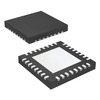Manufacturer Part Number
TRF37A73IDSGR
Manufacturer
Texas Instruments
Introduction
The TRF37A73IDSGR is a high-performance RF amplifier designed for applications in the 1MHz to 6GHz frequency range. This amplifier offers excellent gain, low noise figure, and high linearity, making it suitable for a wide variety of wireless communication systems.
Product Features and Performance
Frequency range: 1MHz to 6GHz
P1dB: 14.5dBm
Gain: 12dB
Noise Figure: 4.5dB
Supply Voltage: 3.3V
Supply Current: 55mA
Test Frequency: 6GHz
Mounting Type: Surface Mount
Package: 8-WFDFN Exposed Pad
Product Advantages
Broad frequency range for versatile applications
High linearity and low noise figure for improved system performance
Low power consumption for energy-efficient designs
Compact surface mount package for space-constrained applications
Key Reasons to Choose This Product
Exceptional RF performance in a small, power-efficient package
Ideal for a wide range of wireless communication systems, including cellular, WiFi, and IoT applications
Proven reliability and quality from a trusted semiconductor manufacturer
Easy to integrate and customize for specific design requirements
Quality and Safety Features
Rigorous testing and quality control processes
Compliance with industry standards and regulations
Robust design for reliable operation in challenging environments
Compatibility
The TRF37A73IDSGR is designed to be compatible with a variety of wireless communication systems and devices, making it a versatile choice for a wide range of applications.
Application Areas
Cellular communication systems (4G, 5G)
WiFi and other wireless LAN technologies
Internet of Things (IoT) devices
Portable electronics and wearables
Satellite communications
Test and measurement equipment
Product Lifecycle
The TRF37A73IDSGR is an active product, and our website's sales team continues to support it. There are no immediate plans for discontinuation. However, customers are advised to contact our website's sales team for the latest information on product availability and potential alternative models.

 TRF37B75IDSGTTexas InstrumentsIC RF AMP GPS 40MHZ-4GHZ 8WSON
TRF37B75IDSGTTexas InstrumentsIC RF AMP GPS 40MHZ-4GHZ 8WSON TRF37B75OIDSGRTexas Instruments
TRF37B75OIDSGRTexas Instruments TRF3762-EIRHBRBB/TI
TRF3762-EIRHBRBB/TI TRF3762-EIRHATTexas InstrumentsIC INTEGER N SYNTH 40VQFN
TRF3762-EIRHATTexas InstrumentsIC INTEGER N SYNTH 40VQFN TRF37A32IRTVTTexas InstrumentsIC AMP GSM 400MHZ-1.7GHZ 32WQFN
TRF37A32IRTVTTexas InstrumentsIC AMP GSM 400MHZ-1.7GHZ 32WQFN TRF37B32IRTVTTexas InstrumentsIC AMP GSM 700MHZ-2.7GHZ 32WQFN
TRF37B32IRTVTTexas InstrumentsIC AMP GSM 700MHZ-2.7GHZ 32WQFN TRF3765IRHBTTexas InstrumentsIC INTEGER-N/FRACTIONAL 32VQFN
TRF3765IRHBTTexas InstrumentsIC INTEGER-N/FRACTIONAL 32VQFN TRF37B73IDSGTTexas InstrumentsIC RF AMP 1MHZ-6GHZ 8WSON
TRF37B73IDSGTTexas InstrumentsIC RF AMP 1MHZ-6GHZ 8WSON